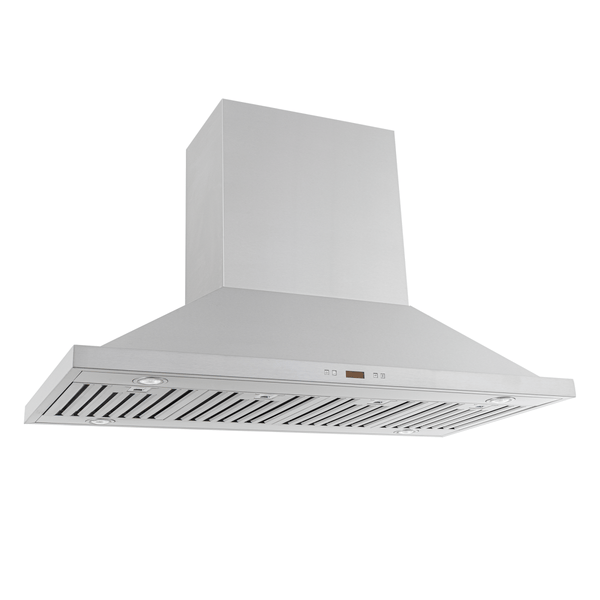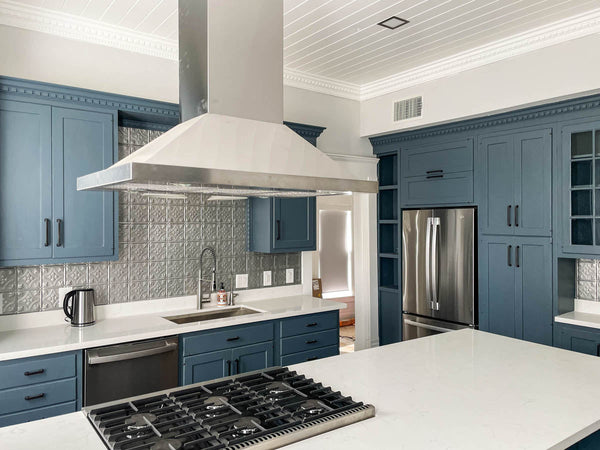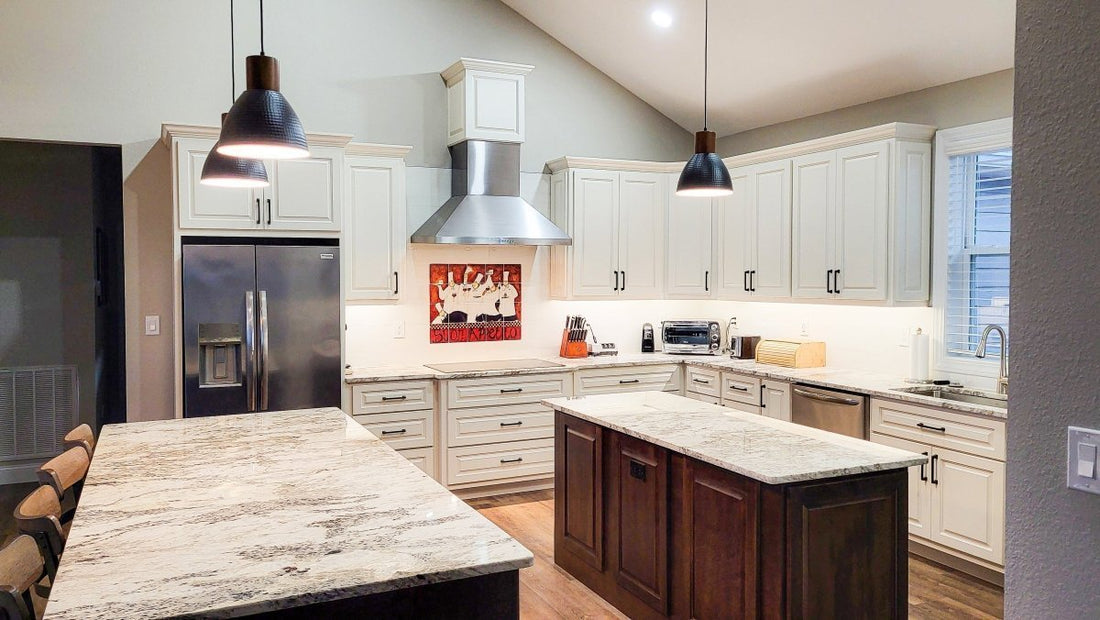Table of Contents
- Which is better: ducted hoods or ductless hoods?
- 4 Reasons Ducted Hoods are Better Than Ductless Hoods
- Should I replace my recirculating range hood with one that is vented outside?
- How do I convert a ductless range hood to ducted?
- Can you install a range hood without a vent?
- Is a ductless range hood better than nothing?
- FAQ
Which is better: ducted hoods or ductless hoods?

When shopping for a range hood, there are many things to consider. One of the most important decisions involves ductwork. Some hoods duct to the outside (ducted hoods) while others do not use ductwork (ductless hoods).
You might shudder at the thought of installing ducting in your home. Maybe you’ve never done it before and you don’t know what’s behind your walls. Not to mention that it sounds expensive.
With this mindset, you’re left wondering: do range hoods have to be vented to the outside?
Range hoods do not have to be vented to the outside. You can purchase hoods without ductwork called ductless hoods. But, ducted range hoods are almost always preferred over ductless hoods. They remove all the smoke and cooking exhaust from your kitchen, while ductless hoods recirculate your cooking exhaust back into your kitchen.
Related: How can range hood inserts improve your kitchen design?
Gas stoves produce a lot of heat and harmful contaminants, so we recommend venting hoods over gas stoves to the outside. Electric stoves aren’t as powerful so you can use a ventless hood in most cases. But we recommend a hood that is vented to the outside to keep your air clean and fresh. Cold air coming through your vent hood? Learn why.
A ductless hood will trap some grease in charcoal filters, but it is not nearly as effective as a ducted hood. You run the risk of wanting more power from your range hood, which you can’t get if it’s at max speed. Ventless hoods also tend to be less powerful than hoods that vent to the outside.
Keep in mind that ducted range hoods must be vented to the outside. You cannot vent your hood into an attic, joists in your ceiling, or a soffit. The grease and moisture will build up which can result in mold growth and even damage your home.
If you’re buying your first ducted hood, it's natural to be anxious about the process. You’ll only buy one, maybe two hoods in your life after all.
For more than 20 years we have specialized in and sold thousands of range hoods to suit any kitchen or cooking style. Explore our hood types, including under-cabinet, wall-mount, island, outdoor, and insert range hoods.
As a first time buyer, you might think that it’s quite a hassle and expense to install a ducted hood. That may lead you to believe that a ductless hood is the way to go. With a ductless hood, you don’t have to worry about ductwork installation, planning, duct size, buying the tools for DIY installation, finding a contractor...the list goes on.
But, ducted hood installation can be easy if you know who to hire. In fact, you can even install the hood yourself.
In short, a ducted range hood is well worth the investment. It will improve your air quality so your friends and family will breathe clean air for years. Not to mention that it’s incredibly convenient, able to vent smoke outside in just minutes.
You’ll get a nice modern upgrade to your kitchen that will make cooking easier. It’s a great conversation starter, too. Chances are, your guests won’t be able to take their eyes off it! Especially if you get a custom range hood from Archways & Ceilings.
We want to keep you informed as you go through the buying process and installation for your hood. Keep reading to learn more!
4 Reasons Ducted Hoods are Better Than Ductless Hoods
More versatile
A ducted range hood allows you to cook a wider variety of food, because it removes the smoke and grease efficiently. You can also use it at lower speeds depending on what you’re cooking. Whereas with a ductless hood, the lower speeds just won’t suck enough air.
More powerful
Most ductless range hoods are 600 CFM or less, while ducted hoods have up to 2000 CFM. This great power makes ducted hoods more reliable. Most homeowners will want more power out of their ductless hood.
If you don’t cook often or you cook in an apartment where ductwork is not allowed, a ductless hood may be the right choice. But avid cooks will definitely want the high-powered fans.
Easier to maintain
You might think that a ductless hood is easier to maintain than a ducted hood. But in addition to baffle or mesh filters, you also have to replace charcoal filters every couple of months.
Also, since ductless hoods have less power, grease and oil may build up on the surface of your hood faster. But a ducted hood sucks those contaminants out of your kitchen air so you don’t need to clean it quite as often.
Baffle filters are dishwasher-safe too, which makes cleaning convenient and easy.
More cost-effective
Ducted and ductless hoods are reliable investments for your kitchen that will last 10 years or more. There are situations where a ductless hood is a great option for your home. If you don’t cook often or you can’t install ductwork, a ductless hood is the way to go. However, when buying a ductless hood you run a small risk of being dissatisfied with the power.
As a result you might need a replacement hood that has more CFM and ducts to the outside. Or you might wear out your range hood quickly by using it on the max speed all the time.
Learn more about range hoods here:
Should I replace my recirculating range hood with one that is vented outside?

If you can, do it. It will upgrade your cooking experience for sure. But do some research first. You want to make the right decision for your home since your hood will be a long term investment.
Consider the following if you want to replace your ductless hood with a ducted one.
Do smoke, grease, and cooking odors remain in your home after using your hood?
This is a sign that your hood is not moving enough air. You probably cook too often or do too much frying, grilling, or Asian cooking for the hood to keep up.
If it can be avoided, we don't want you to be in a situation where you have to replace your hood. So, make sure you know how much CFM you need before making a purchase.
Can you vent your current range hood?
Don’t buy a replacement hood if you can vent your current range hood to the outside. It will save you a lot of time – money too!
There are two things to keep in mind. First, are you satisfied with the CFM of your hood? Venting to the outside will help clean your air, but it might not solve all your problems. You may want to purchase a higher CFM range hood if the smoke and grease buildup is too much.
Second, do you have room for ductwork? If so, great! If not, you can still vent your hood to the outside. But it will take some extra work to plan out the shortest unobstructed path to the outside of your home.
Do you have the right kitchen setup?
Before you replace your hood, make sure you have the right setup that allows for ductwork. It can be helpful to consult a contractor to make sure you have the room for ductwork.
Electrical work or studs within your walls may make venting to the outside difficult. So it’s important to ensure you have an unobstructed path to the outside.
Do you have the budget?
Installing ductwork for most range hoods costs around $200 to $500, depending on the length of the run, size of your duct, and complexity of the installation. Make sure you have the budget before deciding on a replacement hood.
Do building codes allow for a ducted range hood?
Some areas may not allow for ducted range hood installation. Apartments often allow ductless hoods only because there’s no room for ductwork. Most residential homes allow ducted range hoods.
Can my range hood be vented above a heat pump?
We recommend that you vent your range hood only above kitchen ranges or grills. You might consider a commercial hood for your heat pump. But residential hoods are not designed for this. Also, most heating units are outside so you shouldn’t need a range hood.
How do I convert a ductless range hood to ducted?

Many ductless range hoods use recirculating kits that sit on top of the hood and recirculate kitchen air in your home. You will need to check with your hood’s manufacturer to see what is possible with your specific model.
For some hoods like ours, you just need to remove the recirculating kit and install ductwork.
Removing the kit and finding the appropriate duct transition might be a challenge. So again, it’s a good idea to contact the manufacturer before attempting to convert your hood to ducted. They’ll know what you need to convert the hood successfully.
Some hoods can’t be converted from ductless to ducted at all.
**Elevate your kitchen with our cutting-edge range hoods—shop now!
Can you install a range hood without a vent?
Yes, range hoods without vents are called ductless range hoods. They often use recirculating kits that attach to the top of the hood. You’ll also need charcoal filters that trap grease and dirt from your kitchen. These filters sit inside the blower, catching grease and trapping cooking odors as air moves through your hood. Then the recirculating kit pushes the filtered air back into your kitchen.
Some ducted hoods are not convertible. Keep in mind that you can’t install convertible hoods without ductwork.
Remember that ductless hoods aren’t as powerful as ducted hoods. Avid cooks will definitely want a ducted hood for their kitchen.
Is a ductless range hood better than nothing?
Yes! Even though ductless hoods aren’t as powerful as ducted hoods, that doesn’t mean that they are worthless. Far from it! They are a great option for those who don’t cook a lot or people who live in apartments. The charcoal filters neutralize cooking odors and capture grease, keeping your air clean and fresh.
Are they even worth it?
FAQ
-
Do range hoods have to be vented outside?
Range hoods do not have to be vented to the outside. You can purchase hoods without ductwork called ductless hoods. But, ducted range hoods are almost always preferred over ductless hoods. They remove all the smoke and cooking exhaust from your kitchen, while ductless hoods recirculate your cooking exhaust back into your kitchen.
Gas stoves produce a lot of heat and harmful contaminants, so we recommend venting hoods over gas stoves to the outside. Electric stoves aren’t as powerful so you can use a ventless hood in most cases. But we recommend a hood that is vented to the outside to keep your air clean and fresh.Which is better: ducted hoods or ductless hoods?
Although ductless hoods are a viable option for your kitchen, ducted range hoods are better. Here are a few reasons why you should choose a ducted hood over a ductless one, if possible.
- More versatile
- More powerful
- Easier to maintain
- Cost-effective
Should I replace my recirculating range hood with one that is vented outside?
If you can, do it. It will upgrade your cooking experience for sure. But do some research first. You want to make the right decision for your home since your hood will be a long term investment.How do I convert a ductless range hood to ducted?
Many ductless range hoods use recirculating kits that sit on top of the hood and recirculate kitchen air in your home. You will need to check with your hood’s manufacturer to see what is possible with your specific model.
For some hoods like ours, you just need to remove the recirculating kit and install ductwork.
Removing the kit and finding the appropriate duct transition might be a challenge. So again, it’s a good idea to contact the manufacturer before attempting to convert your hood to ducted. They’ll know what you need to convert the hood successfully.
Some hoods can’t be converted from ductless to ducted at all.Can you install a range hood without a vent?
Yes, range hoods without vents are called ductless range hoods. They often use recirculating kits that attach to the top of the hood. You’ll also need charcoal filters that trap grease and dirt from your kitchen. These filters sit inside the blower, catching grease and trapping cooking odors as air moves through your hood. Then the recirculating kit pushes the filtered air back into your kitchen.
Some ducted hoods are not convertible. Keep in mind that you can’t install convertible hoods without ductwork.
Remember that ductless hoods aren’t as powerful as ducted hoods. Avid cooks will definitely want a ducted hood for their kitchen.Is a ductless range hood better than nothing?
Yes! Even though ductless hoods aren’t as powerful as ducted hoods, that doesn’t mean that they are worthless. Far from it! They are a great option for those who don’t cook a lot or people who live in apartments. The charcoal filters neutralize cooking odors and capture grease, keeping your air clean and fresh.Can my range hood be vented above a heat pump?
We recommend that you vent your range hood only above kitchen ranges or grills. You might consider a commercial hood for your heat pump. But residential hoods are not designed for this. Also, most heating units are outside so you shouldn’t need a range hood.












